Abstract
The technique of adsorption of polonium onto metal surfaces by spontaneous deposition has found applications in the analysis of environmental samples such as marine sediments, foodstuff, water, and tobacco since the 1960s. Silver foil has been preferred by many scientists but can become quite expensive for routine analysis. Deposition onto copper was first proposed in the 1970s, but has remained poorly studied. In the present study, the cost-effective and rapid optimum conditions necessary for the optimal recovery of Po from aqueous solutions during spontaneous deposition onto copper foils was evaluated while minimizing the deposition of Bi and Pb, which may interfere with subsequent analyses. A series of experiments was performed to determine adsorption yields for Po, Bi, and Pb to copper foils for a range of pH values from 1.0 to 5.5, with and without stable Bi and Pb carriers. Different methods for cleaning the copper foils were also compared. After initial measurements, Po, Bi, and Pb were desorbed from the disc in plating solutions without added activity. At higher pH values (3.0 and 5.5), less Bi was adsorbed to the copper foils, and subsequent desorption removed up to 99.1% of the plated Bi. The polonium yield remained fairly constant at all pH values and was unaffected by the desorption process. There was also no measureable increase in the polonium activity after 33 days, suggesting that Bi and Pb were not significantly co-deposited. All three cleaning methods performed well, whereas uncleaned foils in the same solution showed limited uptake. The use of copper foil under the optimum conditions described here could provide a valuable alternative to the use of silver in 210Po analyses.
1. Introduction
Polonium-210 (T1/2 138.376 day) belongs to the 238U natural decay series, with immediate parents 210Pb (T1/2 22.3 year) and 210Bi (T1/2 5.013 day). Like the full uranium series, 210Po is ubiquitous in the environment, but usually occurs in trace amounts. Nonetheless, 210Po is considered one of the most radiotoxic naturally-occurring radionuclides [1,2,3] and is therefore an important component of dose assessments [4,5]. Furthermore, in conjunction with 210Pb, 210Po can be used to evaluate a range of environmental processes, such as sediment accumulation [6] and organic carbon fluxes in marine environment [7].
Polonium-210 has been studied in a diverse range of materials including sediments, marine biota, foodstuffs, water, and air and in freshly erupted rocks and volcanic gases. Polonium-210 is mostly measured in sediments to determine the activity of its progenitor 210Pb, which is frequently used to study sediment accumulation rates and surface sediment mixing rates, both of which have implications for understanding the dynamics of other sedimentary species, including contaminants [6,8]. Other researchers such as Su and Huh [9] have reported the measurement of atmospheric Po as a precursor to volcanic eruption several months before eruption. This can be very useful for early warning signals.
It is widely reported that 210Po is concentrated in the tissues of marine organisms and is the largest contributor to the radiation dose received by marine organisms [5,10]. Furthermore, for those people that eat seafood, a significant proportion of their radiation exposure comes via the consumption of 210Po in seafood [11]. For example, 210Po has been reported in whole scallops from the Bay of La Rochelle [12] and in bottom feeders in South Africa near a mine [13]. In Nigeria, Babatunde et al. [14] reported a rough estimate of 210Po intake from consuming marine organisms with a range from 73 to 223 Bq/kg/person/year.
Apart from seafood, other foodstuffs have also been reported to contain 210Po and 210Pb at levels that contribute significantly to the internal radiation dose in humans. For example, Din [15] reported 210Po concentrations in vegetables, fruits, cereals, beverages, and herbs from the city of Qena in Egypt with an estimated effective dose range from 0.008 to 38.3 μSv·year−1. High concentrations of 210Po and 210Pb in terrestrial foodstuffs have also been reported from regions of England and Wales [16], in North Australia Aboriginal foods [17], and in the Syrian diet [2]. A good account of 210Po and 210Pb in terrestrial foodstuffs is given in a review by Persson and Holm [18].
Given the importance and large numbers of samples commonly analyzed for 210Po, a rapid, sensitive, cost-effective method is desirable. For many years, the basis of many methods for 210Po determination has been spontaneous deposition onto metal surfaces, especially silver [4,5,19]. During deposition, its precursors (210Bi and 210Pb) may co-deposit along with 210Po leading to complications in estimating the actual activity of 210Po in the matrix under study; in many cases, interference of Fe3+ may reduce the percentage of Po recovery. A desirable technique should therefore result in the deposition of a high yield of pure 210Po without the co-deposition of its parents or interference from other alpha emitters or impurities such as Fe3+. Usually, after the initial digestion of samples, hydroxyl ammonium chloride (HAC) is employed for the prevention of interference by competing ions in the deposition process, particularly Fe3+ and Cr6+, which can otherwise cause heavy deposits on the plating silver disc and the subsequent loss of counting efficiency and resolution during the a-spectrometric measurement [5].
Silver has long been a preferred metal for deposition [4,19]. However, other metals such as copper have been suggested as alternatives, although the results obtained for deposition efficiency have not been consistent across all studies [4,20,21]. Moreover, considering the current economic climate, it is important to use cost-effective methods, especially where large-scale surveillance is necessary [22]. Cost-effective methods also make the technique readily adaptable to laboratories in less-developed countries. Copper may therefore be preferred to silver because it is (1) easier to manipulate in terms of cleaning with simple techniques using acids and alcohol and (2) cheaper (Ag = $28.7/oz and Cu = $3.36/oz source: www.wtrm.en/22052012).
The present research was carried out at Lancaster Environment Centre, Lancaster University, United Kingdom, to determine the optimum conditions necessary for the selective recovery of pure Po from aqueous solutions onto copper foils without its precursors and to demonstrate the ease of manipulating copper foils for the spontaneous plating of Po. The conditions experimented in the present study were pH, the desorption technique, the use of hold back carriers for Po parents (Bi and Pb), and cleaning of the disc.
2. Materials and Methodology
2.1. Reagents and Experiment
All experiment were carried out using standard laboratory glassware and analytical grade reagents. The experimental procedure involved spontaneous deposition of Pb, Bi, and Po from aqueous solutions onto copper foils in an open beaker for a range of pH values (1.0 to 5.5). For each set of experimental conditions studied, triplicate solutions of approximately 100 mL were made up of demineralized water and 5 mL of a 30% m/v hydroxylammonium chloride solution (Merck Millipore, Darmstadt, Germany), and spiked with known activities of 209Po (0.12 Bq), 207Bi (1.6 Bq), and 210Pb/210Po = 1 (0.69 Bq) (National Physics Laboratory, Teddington, UK). One set of experiments included 5 µg of Bi(NO3)3∙5H2O and 5 µg of Pb(NO3)2 (Fisher Scientific, Loughborough, UK) as stable carriers, while a parallel set contained no carriers. The pH was adjusted to the required value using ammonium hydroxide or 0.5 mol hydrochloric acid before plating (Fisher Scientific, Loughborough, UK). Acidity of the plating solution was maintained throughout the plating time by covering the plating beaker with a petri dish to minimize evaporation. Solutions for the desorption experiments were similarly prepared, but without added radionuclides. The pH was adjusted to 1.0 for all desorption experiments. After the initial measurements, the disc was exposed to the desorption solution for 5 min at room temperature and subsequently exposed to air for about 40 min after which counting was repeated.
Copper foils of 576 mm2 by area and 0.1 mm in thickness were coated on one side with a dichloroacetate (DCA) silicone spray (Electrolube, UK) and allowed to dry at room temperature for 48 h. This was to prevent the uptake of isotopes on the reverse side of the copper foils during plating. After plating, both sides of the copper foils were measured for plated activities of the isotopes. Immediately prior to plating, the uncoated part of the copper foils was normally cleaned by brief immersion in 2 mol/L HNO3 (Fisher Scientific, UK 68% Certified AR) and then rinsed in water and acetone. Two other cleaning methods were employed to determine cheaper and safer alternatives to the use of 2 mol/L HNO3: rubbing with ketchup followed by rinsing with demineralized water, and polishing with emery paper (<0.02 mm2) followed by rinsing with demineralized water. After cleaning, the copper foils were suspended in the solutions and plated at 95 °C with a stirring speed of 600 rev·min−1 for 2.5 h. During plating, care was taken not to allow the copper foils touch the walls of the beaker, and solution lost to evaporation was replaced by adding hot demineralized water. A petri dish was used to cover the plating solution to minimize evaporation, and pH adjusted at the beginning of plating was confirmed at the end of the experiment for wide variation. At the end of the experiment, the copper foils were taken out, quickly dried with paper tissue, and labeled. After the initial measurements, the copper foils were desorbed at room temperature and measured again to compare the change in plated and added activities of the radionuclides.
2.2. Measurements of Isotopes
Bismuth-207 was measured using a coaxial HPGe (High Purity Germanium) detector (EG&G Ortec, Reading, UK), with the 569 keV photopeak, for about 60,000 s. The detector efficiency was determined by counting pure aliquot of 207Bi dried directly onto a copper foil and used as a standard reference material. Po was measured at the photopeak at 5.3 MeV using silicon surface-barrier alpha detectors (Ortec EG&G), with relative efficiencies between 31% and 36%. Detector backgrounds were determined monthly by counting only the empty chambers for 48 h or more and mean count rates obtained for use in activity calculations. The detectors were calibrated using a mixed alpha standard source, and the counting time was 60,000 s.
Uncertainties were calculated using the general expression for combined standard uncertainty u, which is equal to the square root of the sum of the squared contributing uncertainty components, all expressed as standard deviations:
where ∂R/∂xi is the partial differential of the result R with respect to each intermediate value (or other “influence quantity” such as a correction (xi) and u (xi) is the uncertainty component associated with xi. The uncertainties considered in the calculation were spike activity and volume, blank and background, and counting and decay correction.
u = √Σ(∂R/∂xi)2∙u(xi)2
To determine the proportion of Pb deposited on the copper foils, 2.5 mL aliquots of plating solutions before and after plating were measured using atomic absorption spectrometry (AAS type AA 500, Perkin Elmer, Waltham, MA, USA) calibrated with standard solutions made from the same Pb2+ stock solution as the plating solution. The standard solutions were measured before the aliquots of the plating solution with a standard deviation less than 10%. Blanks were also measured.
2.3. Verification of Methods Using Certified Reference Material from the International Atomic Energy Agency (IAEA) and Sediment Samples from Nigeria
Five different sediment samples including IAEA-360 sediment with a known activity range for 210Po (241–620 Bq·kg−1) were digested using a combination of acids in savillex digestion bombs. The sediment samples were spiked with a known amount of 209Po as a chemical yield tracer before digesting on a hotplate at temperatures between 100 and 120 °C. After digestion, the samples were evaporated to insipient dryness, and 50 mL of hydrochloric acid was added. Prior to plating, 5 µg of stable bismuth as a hold back carrier and 5 mL of 30% m/v hydroxylammonium chloride were added, and the pH was adjusted to 3.0 using ammonium hydroxide or hydrochloric acid before the total solution amounted to 100 mL. Each sample was analyzed in triplicates.
At the end of the spontaneous deposition, the copper foils were immediately measured using Ortec EG&G silicon surface-barrier alpha-spectrometry with a detection efficiency of 31%.
3. Results and Discussions
3.1. Adsorption
Generally, 210Po recoveries range from 23% to 89.4%, as shown by the chemical yield of 209Po recovery. Here, the sorption of Po onto the copper foils was not significantly affected by pH variation (Figure 1), and the presence of stable bismuth did not affect the plating efficiency of Po, with average recoveries of 45.6% ± 5.3% and 56.8% ± 3.4% with and without stable bismuth, respectively. The percentage adsorption of Bi was lower than Po with and without stable bismuth. Bi recoveries were higher, with little variation across the range of pH studied without stable bismuth (x̅ = 39.6% ± 5.5%). However, Bi sorption decreased markedly at higher pH values in the presence of stable bismuth (x̅ = 19.5% ± 5.5%) with the least Bi activity (x̅ 7.3% ± 1.3% and 7.2% ± 1.3%) recorded at pH values 3.0 and 5.5, respectively (Figure 2).
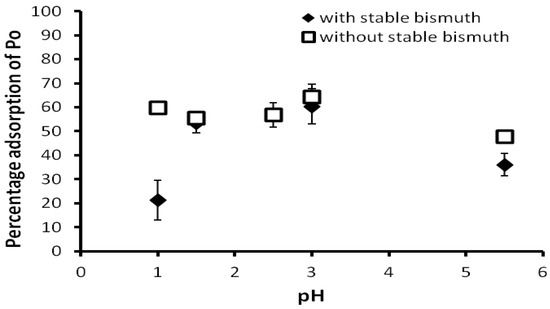
Figure 1.
Mean Po adsorption on copper foils with and without stable bismuth (error bars are standard error, n = 3).
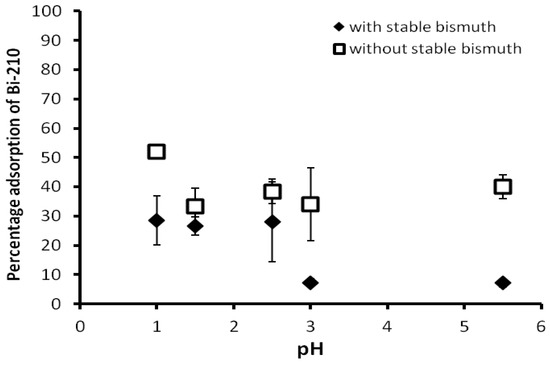
Figure 2.
Mean Bi adsorption plated on copper foils with and without stable bismuth (error bars are standard error, n = 3).
The percentage sorption of 210Pb onto copper foils was determined in two ways: first by a ratio of the initial and second measurement of 210Po after a waiting period of 33 days (Figure 3) and second by the ratio of the percentage yield of stable Pb from an aliquot of the plating solution before and after plating (Figure 4).
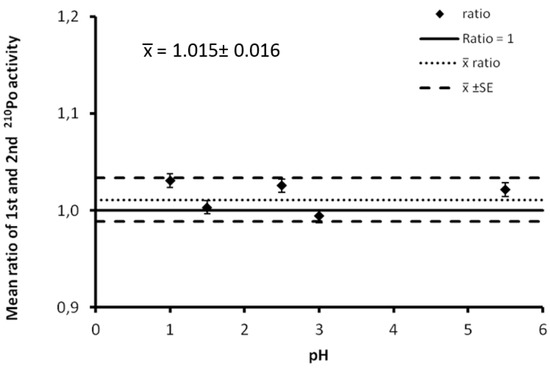
Figure 3.
Mean ratio and standard error of 1st and 2nd counts of 210Po as a function of pH value during deposition (n = 3).
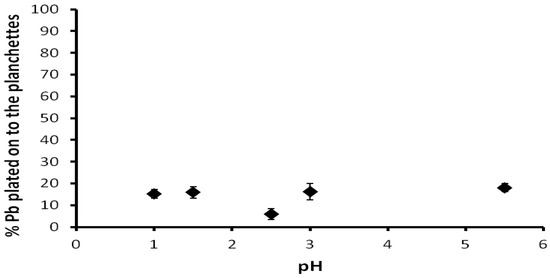
Figure 4.
Mean values and standard errors of Pb2+ co-deposited on the copper foils (n = 3).
Polonium activities measured at first and second measurements are provided in Table 1. According to the first order radioactivity decay law, Po should have decayed by 15% after the waiting period of 33 days. However, given that the mean ratio of the initial and second measurement of 210Po after 33 days was 1.0 ± 0.0 (Figure 3), it is suggested that Po parents were also co-deposited, and their decay gave rise to constant Po after 33 days. However, to avoid this, measurement of Po should be performed immediately after spontaneous deposition.

Table 1.
First and second measurement of 210Po after 33 days.
Stable bismuth as a hold back carrier and pH variation was used to determine the selective recoveries of Po from aqueous solutions using copper foils. Although silver is still more widely used for spontaneous recovery of Po from environmental samples [1,4,5,23,24], copper has the comparative advantage of cost-effectiveness and ease of manipulation and has been preferred by some authors [20,21,25,26,27]. The optimum conditions of temperature, stirring speed, and duration of plating used have been reported in much of the literature to produce a high Po yield during spontaneous adsorption onto copper foils [20,21] and silver foils [19,24].
Po recoveries were up to 70% (x̅ = 60.0 ± 3.0) for the optimum conditions described in the present study, which is comparable to measurements obtained for silver as a planchette [1,5]. Since the recovery of Po onto copper foils is comparable to silver, copper has the comparative advantage of cost-effectiveness and ease of manipulation, as shown in the present study. Percentage recoveries of Po were fairly constant across the range of pH values studied, with pH 3.0 recording the highest activity with and without stable bismuth. However, Bi sorption was significantly affected by pH variation and the presence of stable bismuth. Generally, higher pH values resulted in lower amounts of Bi activity on the disc. The average percentage of Bi activity recovered from the aqueous solution was 39.6% ± 5.5% in the absence of stable bismuth and 19.5% ± 5.5% in the presence of stable bismuth, with the lowest value of 7% at pH values 3.0 and 5.5. Stable bismuth has also been successfully used in some studies as a hold-back carrier during Po recovery via the spontaneous deposition method [19,24,28]. The chemistry of this reaction cannot be fully explained in the scope of this experiment, but it is suggested that the stable bismuth added in form of its nitrate is dissociated in solution, allowing all Bi atoms, including the radioactive Bi, to complex with the nitrate, thereby staying in the solution.
The percentage of Pb2+ plated on the copper foils was averaged at 10.0 ± 2.3, calculated from the ratio of its AAS measurement before and after plating. The number of atoms of Pb2+ plated was used to determine the activity of 210Pb that was plated on the disc and was reported to be insignificant, even for the worst-case scenario of 20% plated Pb2+. Furthermore, the mean ratio of the initial and second measurement of 210Po showed no significant difference from unity (x̅ = 1.0 ± 0.0), indicating that there was no supported 210Po from the 210Pb on the disc after a waiting period of 33 days.
3.2. Desorption
The desorption process had no significant effect on the Po activity plated on the disc across the range of pH values studied with or without stable bismuth (Figure 5). Mean percentages of the plated Po activity remaining after desorption were slightly different with and without stable bismuth—(85.0 ± 7.7) and (97 ± 4.7), respectively. However, plated Bi showed significant removal, especially with a stable bismuth carrier. During desorption experiments, both pH and stable bismuth exerted an influence on the removal of the Bi activity plated on the disc in considerably complex patterns. Bi activity plated at lower pH values without stable bismuth was more readily desorbed compared with almost no significant changes at higher pH values (Figure 6). The percentage of plated Bi activity remaining after desorption was 9% and 91% for pH 1.0 and 5.5, respectively. Bi activity plated at higher pH values with stable bismuth was more significantly desorbed from the disc, and percentages of Bi activity remaining after desorption was 59% at pH 1.0 and 51% at pH 5.0. This complex desorption pattern was better reflected in the percentages of actual activity of Bi added to the plating solutions where, in the absence of stable bismuth, the percentage of added Bi activity remaining after desorption was less at lower pH values and in the presence of stable bismuth; Bi activity was lower at higher pH values with almost no activity left at pH 3.0 and 5.5 (Figure 7).
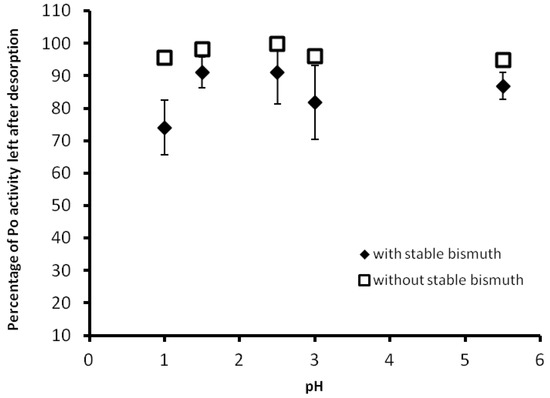
Figure 5.
Mean values and standard errors of plated Po left after desorption with and without stable bismuth (n = 3).
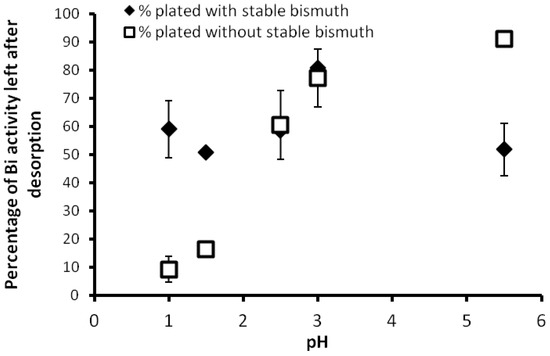
Figure 6.
Mean values and standard errors of Plated Bi activity left after desorption with and without stable bismuth (n = 3).
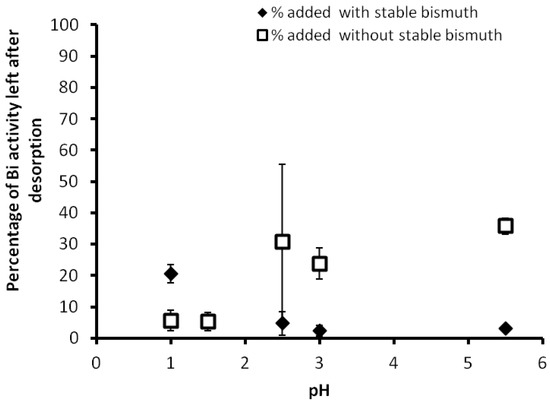
Figure 7.
Mean values and standard errors of added Bi activity left after desorption with and without stable bismuth (n = 3).
Results of the desorption experiments showed remarkable patterns useful for the separation of Bi from Po after deposition onto copper foils. Whereas Po sorption was not significantly affected by the desorption experiment, more than 97% of Bi activity plated and 100% of Bi activity added from the beginning was removed after the desorption exercise. However, the removal of Bi from the disc exhibited different characteristics at different pH values, with and without stable bismuth. Bi activity plated with stable bismuth at higher pH values was more readily desorbed from the disc than at lower pH values (Figure 6 and Figure 7), with pH 3.0 having the least Bi activity left after desorption. On the other hand, Bi activity plated without stable bismuth at lower pH values was more readily removed from the disc than at higher pH values, with pH 1.0 having the least Bi activity left after desorption. This complexity in desorption of Bi was also reported in [20].
3.3. Coating and Cleaning Methods for the Copper Foils
The uptake of Po and Bi on the reverse side of the copper foils was negligible. Average uptake of isotopes on the reverse side of the copper foils were (0.1 ± 0.01) or 10% for Po and (0.01 ± 0.001) or 1% for Bi.
The cleaning of the copper foils had an effect on the deposition of 210Po by facilitating its adsorption. The adsorption of 210Po on the cleaned copper foils was higher compared with uncleaned foils, which showed limited uptake. The three cleaning methods showed similar performance across the range of pH values studied (Figure 8).
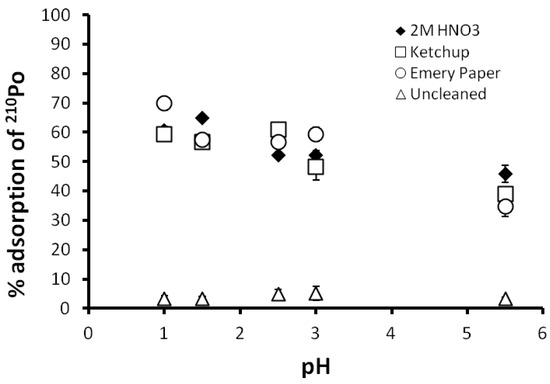
Figure 8.
Mean values and standard errors of plated Po on copper foils cleaned with three methods (n = 3).
The ease of manipulating copper was demonstrated in the coating of the copper foils on one side with DCA silicon spray and the cleaning experiments. The coating of the copper foils on one side with the silicone spray was effective against the uptake of isotopes on the reverse side. This allows Po to be spontaneously deposited in open beakers and eliminates the need for specialized cells for plating Po, which can be expensive for routine analyses. The cleaning methods used in this experiment compared very well with each other presenting a range of opportunities for alternatives, in terms of economic and safety considerations. In comparison, cleaning a silver disc is costly in terms of both time and labor.
3.4. Verification of Method Using Certified Reference Material from the International Atomic Energy Agency (IAEA) and Sediment Samples from Nigeria
210Po recoveries from sediment samples from the Bonny Estuary, Nigeria, ranged from (50.0% ± 1.2%) to (95.0% ± 1.0%), indicating the suitability of the method for 210Po analysis in sediment. There was no statistical difference between the activity measured in the present study and that reported for the same samples by Babatunde et al. [14] at p = 0.104. In addition, average activity of 210Po recorded for the reference material (IAEA-306) sediment sample was 493.2 ± 3.7 Bq·kg−1, which was well within the reported range of 210Po activity in the sample with a chemical yield of 90.3% to 98% by the recovery of 209Po.
The present study demonstrated that the consideration for the co-deposition of Po parents during plating onto copper foils, which has caused most authors to prefer silver, can be allayed using optimum conditions of pH, the desorption technique, and the use of hold back carriers preferred here and also reported by [20].
4. Conclusions
Although silver remains the preferred metal for Po deposition, copper was preferred in this study because of the comparative advantages of its cost-effectiveness, the ease of manipulation, and its high chemical yield of up to 98% by recovery of 209Po.
Po sorption was not influenced by the presence of stable bismuth, pH variation, or the desorption experiment, but the sorption of its immediate parent Bi was significantly lowered by the same conditions. Po can therefore be selectively deposited onto copper foils at an optimum temperature, stirring speed, and plating time with optimum recoveries at pH 3.0. This pH value was also favored for Po adsorption onto copper discs in the report by Mackenzie and Scott [20]. Pb activity deposited during plating was also negligible; according to measurements, there was no supported 210Po from 210Pb after a waiting period of 33 days.
The present experiments also demonstrated that copper is easy to manipulate; moreover, since it is cheaper than silver, it should be preferred. The use of copper therefore may be a more robust alternative in terms of cost-effectiveness and ease of use for routine analysis of Po in aqueous solutions of environmental samples.
Acknowledgment
The authors acknowledge the support of the Commonwealth Scholarship Commission (NGCN-207), the International Foundation of Science (IFS) (W/5246-1), and the Lancaster Environment Centre, Lancaster University, United Kingdom.
Conflicts of Interest
The author declares no conflict of interest.
References
- Jia, G.G.; Belli, M.; Blasi, M.; Marchetti, A.; Rosamilia, S.; Sansone, U. Determination of Pb-210 and Po-210 in mineral and biological environmental samples. J. Radioanal. Nucl. Chem. 2001, 247, 491–499. [Google Scholar] [CrossRef]
- Al-Masri, M.S.; Nashawati, A.; Amin, Y.; Al-akel, B. Determination of Po-210 in tea, mate and their infusions and its annual intake by Syrians. J. Radioanal. Nucl. Chem. 2004, 260, 27–34. [Google Scholar] [CrossRef]
- Al-Masri, M.S.; Mukallati, H.; Al-Hamwi, A.; Khalili, H.; Hassan, M.; Assaf, H. Natural radionuclides in Syrian diet and their daily intake. J. Radioanal. Nucl. Chem. 2004, 260, 405–412. [Google Scholar] [CrossRef]
- Henricsson, F.; Ranebo, Y.; Holm, E.; Roos, P. Aspects on the analysis of 210Po. J. Environ. Radioact. 2011, 102, 415–419. [Google Scholar] [CrossRef] [PubMed]
- Mathew, K.M.; Kim, C.K.; Martin, P. Determination of 210Po in environmental materials: A review of analytical methodology. Appl. Radiat. Isotopes 2007, 65, 267–279. [Google Scholar] [CrossRef] [PubMed]
- Sanchez-Cabeza, J.A.; Masque, P.; Ani-Ragolta, I.; Merino, J.; Frignani, M.; Alvisi, F.; Palanques, A.; Puig, P. Sediment accumulation rates in the southern Barcelona continental margin (NW Mediterranean Sea) derived from Pb-210 and Cs-137 chronology. Prog. Oceanogr. 1999, 44, 313–332. [Google Scholar] [CrossRef]
- Stewart, G.M.; Fisher, N.S. Experimental studies on the accumulation of polonium-210 by marine phytoplankton. Limnol. Oceanogr. 2003, 48, 1193–1201. [Google Scholar] [CrossRef]
- Garcia-Orellana, I.; Garcia-Leon, M. An easy method to determine Po-210 and Pb-210 by alpha spectrometry in marine environmental samples. Appl. Radiat. Isotopes 2002, 56, 633–636. [Google Scholar] [CrossRef]
- Su, C.-C.; Huh, C.-A. Atmospheric 210Po anomaly as a precursor of volcano eruptions. Geophys. Res. Lett. 2002, 29, 14. [Google Scholar] [CrossRef]
- Fowler, S.W. 210Po in the marine environment with emphasis on its behaviour within the biosphere. J. Environ. Radioact. 2011, 102, 448–461. [Google Scholar] [CrossRef] [PubMed]
- Chen, Q.J.; Hou, X.L.; Dahlgaard, H.; Nielsen, S.P.; Aarkrog, A. A rapid method for the separation of Po-210 from Pb-210 by TIOA extraction. J. Radioanal. Nucl. Chem. 2001, 249, 587–593. [Google Scholar]
- Bustamante, P.; Germain, P.; Leclerc, G.; Miramand, P. Concentration and distribution of Po-210 in the tissues of the scallop Chlamys varia and the mussel Mytilus edulis from the Coasts of Charente-Maritime (France). Mar. Pollut. Bull. 2002, 44, 997–1002. [Google Scholar] [CrossRef]
- Faanhof, A.; Louw, I. The measurement of natural radioactivity in fish and the impact on humans. J. Radioanal. Nucl. Chem. 2001, 249, 227–232. [Google Scholar]
- Babatunde, B.B.; Sikoki, F.D.; Hart, I. Human health impact of natural and artificial radioactivity levels in the sediments and fish of Bonny Estuary, Niger Delta, Nigeria. Challenges 2015, 6, 244–257. [Google Scholar] [CrossRef]
- Din, K.S. Determination of Po-210 in various foodstuffs and its annual effective dose to inhabitants of Qena City, Egypt. Sci. Total Environ. 2011, 409, 5301–5304. [Google Scholar] [CrossRef] [PubMed]
- McDonald, P.; Jackson, D.; Leonard, D.R.P.; Mckay, K. An assessment of 210Pb and 210Po in terrestrial foodstuffs from regions of England and Wales. J. Environ. Radioact. 1999, 43, 15–29. [Google Scholar] [CrossRef]
- Martin, P.; Hancook, G.J. Routine Analysis of Naturally Occurring Radionuclides in Environmental Samples by Alpha-Particle Spectrometry; Supervising Scientist Report 180; AGPS: Canberra, Australia, 2004. [Google Scholar]
- Persson, B.R.R.; Holm, E. Polonium-210 and lead-210 in the terrestrial environment: A historical review. J. Environ. Radioact. 2011, 102, 420–429. [Google Scholar] [CrossRef] [PubMed]
- Flynn, W.W. Determination of low levels of polonium-210 in environmental materials. Anal. Chim. Acta 1968, 43, 221–234. [Google Scholar] [CrossRef]
- Mackenzie, A.B.; Scott, R.D. Separation of Bi-210 and Po-210 from aqueous-solutions by spontaneous adsorption on copper foils. Analyst 1979, 104, 1151–1158. [Google Scholar] [CrossRef]
- Karali, T.; Olmez, S.; Yener, G. Study of spontaneous deposition of Po-210 on various metals and application for activity assessment in cigarette smoke. Appl. Radiat. Isotopes 1996, 47, 409–411. [Google Scholar] [CrossRef]
- Clayton, R.F.; Bradley, E.J. A cost effective method for the determination of Po-210 and Pb-210 in environmental materials. Sci. Total Environ. 1995, 173, 23–28. [Google Scholar] [CrossRef]
- Holtzman, R.B. The determination of Pb-210 and Po-210 in biological and environmental materials. J. Radioanal. Nucl. Chem. 1987, 115, 59–70. [Google Scholar] [CrossRef]
- Jia, G.G.; Belli, M.; Blasi, M.; Marchetti, A.; Rosamilia, S.; Sansone, U. Pb-210 and Po-210 determination in environmental samples. Appl. Radiat. Isotopes 2000, 53, 115–120. [Google Scholar] [CrossRef]
- Vajda, N.; Larosa, J.; Zeisler, R.; Danesi, P.; Kisbenedek, G. A novel technique for the simultaneous determination of Pb-210 and Po-210 using a crown ether. J. Environm. Radioact. 1997, 37, 355–372. [Google Scholar] [CrossRef]
- Benedik, L.; Vrecek, P. Determination of Pb-210 and Po-210 in environmental samples. Acta Chim. Slov. 2001, 48, 199–213. [Google Scholar]
- Vrecek, P.; Benedik, L.; Pihlar, B. Determination of Pb-210 and Po-210 in sediment and soil leachates and in biological materials using a Sr-resin column and evaluation of column reuse. Appl. Radiat. Isotopes 2004, 60, 717–723. [Google Scholar] [CrossRef] [PubMed]
- Godoy, J.M.; Schuttelkopf, H.S. A Radiochemical Procedure for the Determination of Po-210 in Environmental Samples; Kernforschungszentrum Karlsruhe: Karlsruhe, Germany, 1980. [Google Scholar]
© 2016 by the author; licensee MDPI, Basel, Switzerland. This article is an open access article distributed under the terms and conditions of the Creative Commons Attribution (CC-BY) license (http://creativecommons.org/licenses/by/4.0/).